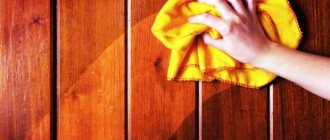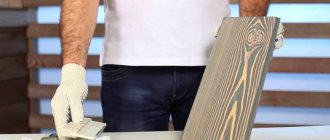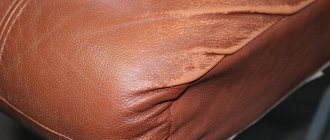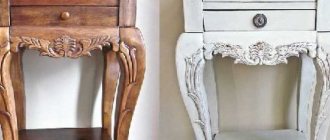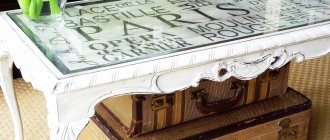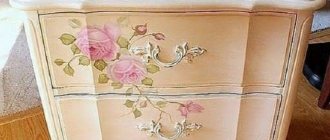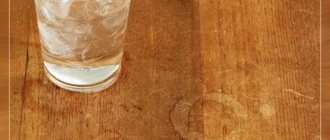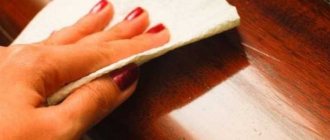What is MDF
First, it’s worth understanding what MDF is. Translated from English, the abbreviation “MDF” translates as “medium density fiberboard.” This material is made from wood fibers.
MDF production includes the following stages:
- Sawdust is crushed to a powder state. To do this, the raw materials are brought to 100 degrees temperature and 80 percent humidity. And then it is ground in a defibrator.
- Then urea-formaldehyde resins and paraffin are added to the powder. The mass is thoroughly mixed and dried at a temperature of 200 degrees. By the way, the mixture dries within a few seconds.
- The resulting mass is transferred to a hopper and compacted, and then rolled out with a roller along a conveyor. This creates a slab.
- It is fed to the press, and under a pressure of 350 MPa and when heated to 230 degrees, the pressing stage goes through. After this, the pressure decreases three times and the process of adjusting the thickness of the plate takes place without high temperatures.
- The cooled slab is sanded and cut into pieces of the required size.
If you cannot find special paint for MDF, you can use painting compounds for windows and doors, or for wood.
Fiberboard is one of the most commonly used materials in the furniture industry. And this is no coincidence. MDF has enough advantages:
- Moisture resistance;
- Strength;
- Availability;
- Long service life;
- Possibility of creating various reliefs and decor;
- Resistance to temperature changes;
- Wide range of applications.
You can paint the furniture yourself.
Often, happy owners of MDF furniture believe that it is impossible to repaint such interior items with their own hands. But in vain. Everything is much simpler than it might seem at first glance. The main thing is to choose the right paints, namely:
- Primer compositions;
- Paints with high hiding power and wear resistance;
- Varnishes or polishing kits.
With a wide range of colors to choose from, you are sure to find something that suits you.
By painting MDF surfaces, you will refresh the interior, extend the service life of products and significantly improve performance. The latter is especially true if you decide to update the furniture in the bathroom or kitchen.
Choose quality paint manufacturers.
However, there are also disadvantages to coloring. Firstly, it will cost you much more than covering the facades with decorative film. And, secondly, painted surfaces fade over time.
Do-it-yourself MDF painting at home: choice of paints and varnishes, rules for applying compositions
The abbreviation MDF stands for finely dispersed fraction. This material, invented in 1966 in the USA, is a slab of medium-density wood fibers pressed under high pressure.
Today MDF has gained universal recognition, for example, among furniture manufacturers. And if you have pieces of MDF furniture at home, they can easily be repainted - this is an inexpensive and effective way to change the situation. In addition, painting can additionally protect MDF surfaces from negative environmental factors.
Modern technologies and materials make it possible to paint kitchen facades or other pieces of MDF furniture at home quite efficiently.
Paints that can be used
To paint MDF boards yourself, it is best to take enamels, since they form a durable opaque film and come in glossy and matte finishes. The following materials can be used:
- alkyd, alkyd-urethane or oil-based enamels;
- based on polyurethane resins;
- acrylic enamels;
- nitro paints of the NTs series;
- professional two-component polyurethane enamels;
- specialized enamels for MDF;
- automotive enamels.
Each of these materials has its own characteristics. But perhaps the last two items on the list have the best properties.
It is especially worth noting that in industrial conditions today powder coating of MDF facades is often used. This method is extremely economical and makes it possible to achieve high mechanical and chemical costs. The method is based on the ability of unlike charges to attract each other. It was originally used for ceramics, metals and other materials that can withstand high temperatures.
It is now almost impossible to paint MDF facades using a powder method in standard home conditions. This type of painting requires special, expensive equipment that can only pay for itself with constant, frequent use, and it’s unlikely to be placed at home.
Types of varnishes
Instead of painting, you can choose varnish. To reliably varnish MDF, you need to apply several layers and wait until it dries completely each time. The process will take a long time and require effort.
If you still decide to choose a varnish, then pay attention not only to its cost and composition, but also to wear resistance, resistance to humidity, and high temperature. To coat MDF boards at home, you can use several different types of varnishes.
The cheapest compositions in this segment are alcohol-based and have a short drying time (up to half an hour), that is, they are quick-drying. Traditional inexpensive varnishes include oil-based varnishes, which not only give a beautiful appearance to surfaces, but also effectively protect them from moisture.
Note! For coating MDF countertops, an excellent choice would be two-component epoxy varnishes, which are characterized by increased resistance to impact.
Acrylic varnishes are good because they are odorless, do not emit toxic substances, and are not washed off or diluted with water. Another popular option is polyurethane varnish. It is characterized by enviable wear resistance and good adhesion to wood-based materials.
As for those cases where further polishing of MDF products is expected, nitrocellulose varnishes are the best option.
Sanding and sanding the surface
In paint and varnish work, home or industrial, proper surface preparation is important. In order for the paint to adhere well to the MDF board in the future (for example, on facades or wall panels), it is necessary to first sand them.
Certain tools are required for grinding:
- sandpaper;
- soft abrasive of fine grain;
- sanding machines for primer.
If the product to be painted is small in size, then use sandpaper on foam rubber in a grade from P220 to P280. To clean large flat surfaces, fine-grained sanding mats of the 700 series are used. The same materials can be used to remove excess soil in the future.
MDF facades are sanded over the entire plane, removing the top layer of varnish. Complex curves in the milling of MDF facades, edges, edges and ends are best cleaned with the same sandpaper.
When sanding, you must follow the technology for removing old varnish, you must not allow the surface to overheat (if you are using a power tool), and you must not allow so-called marks (scratches) to appear on the lamination. The wood-fiber surface, as a rule, is located under a decorative laminated film, so when sanding, you cannot wipe the top layer to holes. The chips are separately cleaned of dirt and the edges are sanded.
After sanding, the surface will become matte and rough. Then the dust is swept away (sucked in with a vacuum cleaner), and the surface of the slab is washed with a solvent. It will remove possible fat deposits, excess moisture, and dirt.
Primer coating
Before painting, it is highly advisable to treat MDF with a primer. This processing is carried out in two passes. At the first stage, the insulating soil is sprayed using a spray gun at the rate of 90-100 grams per square meter.
Note! If you intend to paint laminated MDF board (LMDF), then you can do without priming and immediately move on to the next step.
Preparation
As with any task, preparation plays a very important role in the process of painting furniture at home. First of all, the furniture is disassembled before painting. At least take the doors off their hinges. Thanks to this, the process of applying paint will become more convenient, and parts that do not need to be painted will be protected from the ingress of paint.
Take a responsible approach to the process of preparing furniture.
Working surfaces are thoroughly washed and degreased. This is done using an aqueous solution of dishwashing liquid, vodka (or alcohol). Then, using a special wood putty, chips and cracks are removed.
Grinding
In order for the coloring composition to lay down in an even layer and form reliable adhesion to the surface, the area of future painting is sanded. For processing a small area, ordinary sandpaper is suitable, but if you have to do global sanding of large surfaces, it is better to use a sanding machine.
Use special materials for sanding MDF.
To ensure that the puttyed chips and cracks take the shape you want, use a special abrasive mesh.
Attention! While operating the grinder, do not allow the working surfaces to overheat.
After sanding, the dust is removed with a vacuum cleaner, and then the surface is treated with a solvent.
Use paint remover.
The effectiveness of this treatment is noticeable visually and to the touch: the treated areas become matte and rough.
Primer
Now you can start priming. This stage is considered one of the most important. The final result of all your work on painting MDF furniture depends on its high-quality execution.
Choose a quality primer.
The correctly selected composition copes with the following tasks:
- Provides reliable adhesion of paint to the surface being treated;
- Increases the strength of the top layer;
- Masks minor defects;
- Prevents the rise of pile on the surface of MDF;
- Reduces paint consumption due to reduced absorption.
High-quality staining will improve the appearance of the furniture.
Most often, a two-component polyurethane or water-dispersion primer is used for MDF. The process itself takes place in two stages:
- First, the end and protruding elements are primed, and then the entire surface. After the first layer has dried, raised fibers and other defects are removed using a sanding sponge. But they do this extremely carefully so as not to damage the primer layer to the base.
- The dust formed after grinding is removed from the surface and primed again. White polyurethane primer is applied at the rate of 150 grams per 1 square meter. m. Leave until completely dry (usually this takes from 8 to 24 hours). The dried surface is treated with a Scotch-Brite sanding sheet.
A special device will help you quickly paint MDF.
Dyeing process
We figured out the compositions, and now you know whether it is possible to paint MDF panels and with what exactly.
It's time to puzzle you with some of the nuances of the upcoming process, telling you how to paint MDF:
Schematic representation of the process.
- Any surface must be pre-treated with primer. It fills the pores of the material, preventing further absorption of the finishing coating (paint);
- After applying the primer and drying, the surface must be sanded to remove raised wood fibers. It is best to use a grinder for these purposes;
- The surface should be cleaned of dust, and only then apply the first coat of paint;
- Repeat the sanding process again to remove any raised fibers from the surface;
- Then apply a second coat of paint;
- To give a complete appearance, the surface should be polished.
Hand painted MDF panel.
Important: when applying paint to a previously painted surface, it should be degreased. If the surface has been laminated, it will need to be treated with an adhesive primer.
Types of paints
There are enough coloring compounds suitable for MDF, so you have the opportunity to choose both in composition and price.
- Alkyd. Valued for its ductility and strength. However, if furniture painted with such compositions is exposed to direct sunlight, the surface will quickly fade.
- Oily. Such paints are very demanding when it comes to primer.
- Water-based. Perhaps the easiest to use. They dissolve in water, dry very quickly, do not have an unpleasant odor and do not emit harmful substances. But this is where the advantages end, and as for performance characteristics, water-based emulsion “loses” to almost all other coloring compounds.
- Acrylic-silicone. Harmless, highly durable, helmets have only one drawback - their high price.
- Polyvinyl acetate. These paints are very demanding in terms of application technology. If you do not follow the recommendations, the paint from the surface begins to peel off.
Today you will find a variety of paint colors.
If you have the opportunity to use car paints, don't miss it. Automotive enamel forms a thin, opaque layer on the surface, and after drying it gives a beautiful gloss. This coating will serve you faithfully for many years.
You can constantly update the look of your furniture.
Step-by-step instructions for coloring
Before starting work, remove doors, shelves, handles and other fittings from the piece of furniture. Cover glass or mirror inserts with masking tape. Cover the area where painting will be done with a protective film.
Surface preparation
First, remove any grease or dirt from the surface. To do this, you can wash it with the addition of a cleaning agent. Use wood putty, such as acrylic or car putty, to seal all cracks and chips, first cleaning them with the blunt part of a knife. Chips on the edges and corners should also be treated. If the putty will have to be applied in several layers, wait until each layer has hardened before applying the next one.
Pay attention to: How to remove paint from furniture at home: recommendations for beginners
After all layers have completely dried, carefully sand the surface - this will remove excess putty, and the MDF board will become rough, which is necessary for good adhesion to the paint. After this, use a rag or vacuum cleaner to remove dust from the item you are preparing to repaint.
Primer
The final result depends on the quality of the primer - it not only increases the adhesion of the material, but also eliminates minor defects. By reducing the absorption of the primed surface, paint consumption is reduced. It is recommended to use a universal polyurethane primer.
Start with the ends and raised parts, then apply primer to the entire surface of the product. Let the first layer dry completely, sand it and cover it with a second and, if necessary, a third, etc. Before applying the last layer, the MDF is sanded again.
Selecting paint type and color
To repaint MDF furniture in a bedroom or children's room, it is better to use water-based acrylic or silicone paint. They are easy to spread and apply, dry quickly, do not have an unpleasant odor and are safe for others. In living rooms and children's rooms, you can use furniture enamels with high abrasion resistance.
Surfaces painted with polyvinyl acetate-based compounds quickly become dirty and destroyed when exposed to moisture, so they cannot be used to paint kitchen furniture or bathroom cabinets. In rooms with high humidity, it is better to use silicone enamel; it is elastic, which helps compensate for the thermal expansion of MDF boards.
Wear-resistant polyurethane and automotive aerosol paints are well suited for kitchen facades. Compositions containing latex have a dirt-repellent effect, so they are suitable for cabinet fronts in the kitchen or hallway.
Alkyd paints are cheaper than others, which is important when you need to paint a large area. They are easy to work with, but it takes up to three days for them to dry completely. They contain substances harmful to health and have a persistent, pungent odor that does not disappear for a long time, so only furniture used in non-residential premises can be painted with alkyd enamels.
Paints and varnishes are transparent and pigmented. The first ones will emphasize the structure of the wood if the MDF is covered with veneer. In construction stores you can buy a ready-made color mixture or tint, which is added to white paint to give the desired shade. To determine what tone you will get, paint a small area; you may need to add more color.
Applying paint
The most beautiful furniture is obtained when using a spray gun. Painting with aerosols gives a good result, but the room can suffer from heavy splashing, so the easiest way is to use a brush or roller suitable for the selected paint composition. Move the tool in one direction only during operation.
Pay attention to: Painting chipboard furniture at home: tips for beginners.
After the paint has completely dried, apply another coat to seal the effect. If something gets on a freshly painted item, carefully remove it with the tip of a knife. Sand any defects formed after drying and carefully touch up with a cotton swab.
Varnish finish
Repainted furniture that will be used frequently or will be placed in a place where it will be exposed to elevated temperatures and sunlight is recommended to be coated with a clear varnish. Surfaces reinforced in this way better withstand high temperatures and can be used to place heated dishes.
Varnishes are also used for decoration - with their help, the coating of interior items can be made pearlescent or silky matte, as well as achieve a glossy effect. Apply the varnish carefully, carefully following the instructions. After the varnish finish has dried, you can begin assembling the updated furniture.
Read further:
How to repaint lacquered furniture with your own hands
Painting chipboard furniture at home: tips for beginners.
How to remove paint from furniture at home: recommendations for beginners
Painting leather furniture
Detailed instructions for reviving old furniture with your own hands
Technological process
The most convenient way to paint is with a spray gun. If you don’t have one and you can’t purchase such a unit (or simply don’t want to), use a roller. The main thing is that the roller has short pile. As a last resort, you can paint it with a brush, also with fine bristles. When purchasing, consult with the seller which roller (brush) to purchase, depending on the coloring composition that you plan to use.
The vast majority of experienced painters prefer to use spray paints. But such a solution has both strengths and weaknesses. The undeniable advantages include uniform application of the paint and varnish composition and, as a result, an excellent final result.
The end result will definitely please you.
Well, the main disadvantage is that nearby objects are necessarily painted without your consent. In other words, this method is quite “dirty”, and in order to avoid serious losses, it is recommended to paint in a separate room that you don’t mind getting dirty.
A spray bottle will help in painting furniture.
Be sure to paint in one direction. Usually two layers are enough. The main rule: each subsequent layer is applied only after the previous one has completely dried.
Changing the facade yourself not only saves money, but also allows you to make it as intended.
And work should be performed at a temperature of at least 15 degrees Celsius. To avoid poisoning by fumes, as well as to avoid paint getting on your skin or eyes, you should always wear protective glasses and gloves when working.
Photo: how to remake old furniture.
If you notice a defect in a painted area, eliminate it, sand the surface and carefully repaint with a cotton swab using light blotting movements. If a speck is found on a freshly painted façade, remove it using a sharp object, such as a knife.
View of an old product after restoration.
Most often, after painting, polishing of the product is required. The surface must be absolutely dry, there should be no dust or small debris on it, since any lint will be very noticeable in the light. If you are varnishing in several layers, remember that the first one should be the thinnest, and subsequent ones should be applied only after the previous one has completely dried.
You can choose to cover it with paint or varnish, and also decorate the sample using scrap materials.
After varnishing, the surface is sanded again. First, coarse-grained paper is used for this, and then fine-grained paper. To prevent pellets from appearing, the working surface is periodically moistened with water. A week after painting, polishing and sanding, the product is sanded again using an abrasive paste.
Don't throw away old furniture.
So, tired of furniture? Don't throw it away. It’s better to think about what bright color you can repaint a familiar interior element. And take action!
Improve your room design!
Perhaps you will find the painting process not only practical, but also exciting, and you will be happy to color other pieces of furniture.
How to paint MDF panels
MDF panels are a building material intended for finishing premises, cladding the facades of cabinet furniture or walls; it is made from wood chips of low or medium thickness.
These parts are considered an environmentally friendly finishing element, since synthetic adhesives are not used in their production, but natural wood resin is used, which reliably fixes all layers of the product and forms a single whole. MDF panels have medium and low density, depending on the number of layers and composition of the wood.
Over time, during the operation of these parts, their surface may become scratched, the coating loses its gloss or has defects, as a result, the integrity of the entire panel is compromised, and the appearance of the entire finish becomes unsightly. In this case, any owner is faced with the question: how to update the facade of the panels without completely changing them?
MDF panels on the wall
This article discusses the possibility of painting products such as MDF wall panels, whether it is possible to paint MDF, as well as the process of carrying out such work at home.
Reasons for the formation of defects
There are a number of reasons why painting MDF panels may be necessary, including:
- Mechanical damage to the surface as a result of impact with a sharp object or other material. The top layer of the MDF panel consists of laminated or plain paper with paint applied to it; when exposed to a hard object, the film breaks, which exposes the core of the entire product;
- Paint fading, loss of color brightness. This deformation is caused by exposure to ultraviolet rays and atmospheric air, which contains a small amount of moisture. Over time, the coating becomes matte, loses its shine and original appearance;
- Temperature changes also negatively affect the external condition of the surface of MDF panels, since the internal structure consists of wood, which absorbs moisture from the atmosphere and at the same time swells over the entire area. When the temperature rises, MDF dries out and may crack; moreover, the glue contained in the panel loses its ability due to moisture, which leads to peeling of paper, lamination and shavings.
MDF and water
These causes of deformation lead to an unsightly appearance of the entire surface and disrupt the overall design of the wall. If these defects occur, you can paint MDF panels after first completing a number of preparatory procedures, but you should understand that painting parts with your own hands at home brings a result that differs from processing with paints in production.
Painting process for MDF panels
How to attach PVC panels to the wall
Before answering the question of how to paint MDF panels, you need to understand the composition of this product. An MDF board, wall or facade, consists of several layers of compressed paper and sawdust, laminated with a transparent or colored film on the front side. Most often, it is the top layer that is subject to damage and wear, so when planning to update MDF, you need to prepare the specified types of coatings.
In order to prepare MDF panels for painting at home, you will need:
- Sandpaper for preparing the surface and removing gloss or varnish;
- Solvent for degreasing the surface from glue and liquid residues;
- Dry rags or other lint-free cloth.
These materials are necessary for pre-treatment of MDF panels for painting and sealing cracks and scratches on the laminate.
Priming MDF panels
All work must be carried out in accordance with the action algorithm. The first step is to sand the panel with fine sandpaper; this can be done manually or using a pneumatic tool.
It is important to follow the varnish removal technology, to prevent overheating of the surface or the formation of large marks on the laminate. The wood-fiber surface is under the decorative film, so when sanding you need to carefully monitor the thickness of the top layer so as not to erase it completely.
After this procedure, the coating will no longer shine and will become rough and slightly scratchy.
Next, you need to clean all cracks and chips from dirt and dust, and also clean their edges. All irregularities, if necessary, are smoothed over with a special putty, which forms a single whole with the base of the panel; it also needs to be leveled with sandpaper.
After the surface has been processed and leveled, it must be wiped with a dry cloth and degreased with a chemical solvent, which will displace and evaporate all water and wash away dust and dirt.
The next step is to prime the top coat with a special paint; it has a grainy texture and can be applied using compressed air or a simple brush. It can be used to cover the surface in several layers, with intermediate sanding, until the required smoothness is achieved.
Next, the base paint is prepared, tinted and thoroughly mixed so that all the elements are mixed together. You can paint MDF panels manually or with a special pneumatic gun, but this will require a compressor unit and a moisture-water separator. The composition is applied with smooth movements in two layers: the first - across the main direction, the second - along the entire length of the part. Thus, the formation of smudges and paint sagging is prevented.
The final step will be to treat the top paper-wood layer of the panel with transparent varnish. This procedure is not necessary, but after it is carried out, the surface of the MDF product becomes glossy, its top layer seems renewed, and the appearance of the entire structure is restored.

